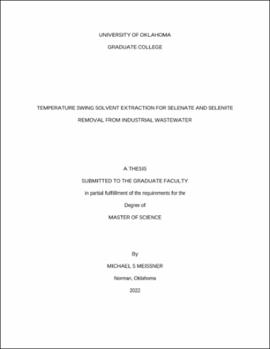| dc.contributor.advisor | Bui, Ngoc T | |
| dc.contributor.author | Meissner, Michael S | |
| dc.date.accessioned | 2022-05-06T21:13:45Z | |
| dc.date.available | 2022-05-06T21:13:45Z | |
| dc.date.issued | 2022 | |
| dc.identifier.uri | https://hdl.handle.net/11244/335594 | |
| dc.description.abstract | Coal-fired power plants provide more than one fifth of the electricity generated in the United States. Flue gas desulfurization (FGD) of the products of coal combustion is necessary to prevent emissions of SO2, which is typically accomplished with wet scrubbing systems. The wastewater from these systems contains high levels of gypsum, chloride, and trace heavy elements including selenium. Effective treatment of FGD wastewater remains a challenge. In this thesis, temperature swing solvent extraction was investigated for its ability to produce freshwater from saline and selenium-containing wastewater. Solute rejection for extractions with diisopropylamine (DPA) was dependent on the ionic strength the feed. DPA showed no selectivity for feeds containing 500 ppm selenate and 500 ppm selenite. NaCl rejection of 81% was achieved for a 3.5 w/w% NaCl feed, and the rejection rose to 93% for the 4.0 NaCl feed. For extractions with synthetic FGD wastewater, DPA rejected 86% of feed selenate and 74% of feed NaCl, indicating DPA can treat dilute contaminants in high TDS feeds. Due to the diminishing solute rejection with more dilute feeds, it was concluded that standalone extraction with DPA is not suitable for FGD wastewater treatment. Extraction with decanoic acid displayed over 98% solute rejection for 3.5 w/w%, 1.0 M, and 4.0 M NaCl feeds. Decanoic acid maintained this rejection for feeds containing 500 ppm selenate and 500 ppm selenite, showing stable rejection of ions independent of feed concentrations. The rejection of each species was slightly lower for synthetic FGD wastewater at 96% for selenate and 95% for NaCl. It was concluded that extraction with DA was feasible as a standalone FGD wastewater treatment. Rejections of selenite were higher than selenate, which were higher than chloride. Selenite has the largest hydrated radius and chloride the smallest, suggesting this property influences ion rejection in multicomponent feeds. Finally, higher DA solute rejection but lower water recovery compared to DPA suggests a tradeoff. | en_US |
| dc.language | en_US | en_US |
| dc.subject | Flue gas desulfurization wastewater | en_US |
| dc.subject | Desalination | en_US |
| dc.subject | Temperature swing solvent extraction | en_US |
| dc.subject | Selenium removal | en_US |
| dc.title | Temperature Swing Solvent Extraction for Selenate and Selenite Removal from Industrial Wastewater | en_US |
| dc.contributor.committeeMember | Galizia, Michele | |
| dc.contributor.committeeMember | Papavassiliou, Dimitrios V | |
| dc.date.manuscript | 2022 | |
| dc.thesis.degree | Master of Science | en_US |
| ou.group | Gallogly College of Engineering::School of Chemical, Biological and Materials Engineering | en_US |
| shareok.orcid | 0000-0001-9644-2556 | en_US |
